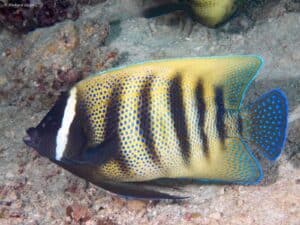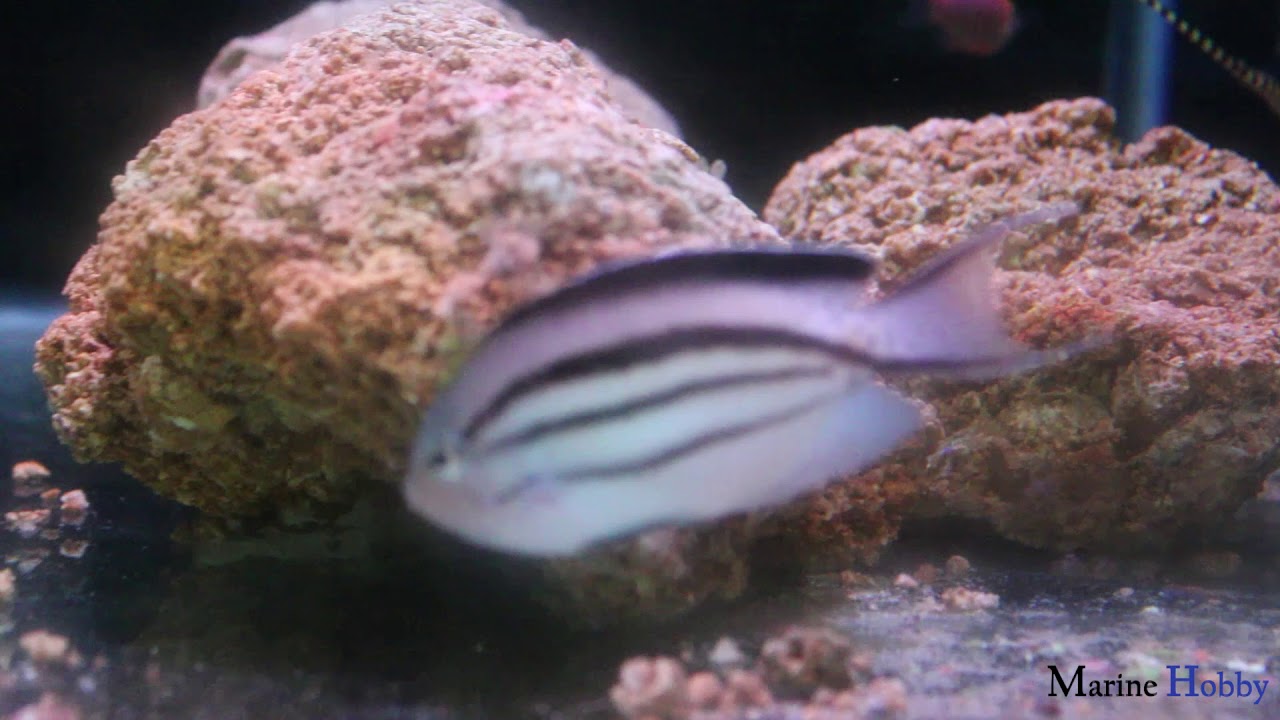Genicanthus lamarck – Blackstriped Angelfish
Genicanthus lamarck was officially described by Lacepède in 1802.The name Genicanthus is derived from two ancient Greek words. Geny means face or jaw and akantha means thorn. They belong to the Pomacanthidae family or Emperor fish. This family has about 7 genera and 86 species. Many emperor fish are brightly colored, not too large, which is why they are widely kept in the aquarium.
Synonyms: Holacanthus lamarck, Genicanthus lamarcki, Genicanthus lamark.
Description
Blackstriped Angelfish are not as colorful as some other Emperor fish. They have a white color but on it a number (three to six) of black horizontal stripes across the flank. The dorsal fin also has a black stripe. Black spots are visible on the rear part of the body and the dorsal, anal and caudal fins. They grow to a maximum length of about 25 centimeters .
The difference between males and females can be seen in a number of differences. In the female , the upper stripe on the flank runs in an arc that continues to the lower edge of the caudal fin. In males the stripes are thinner and run almost horizontally. The ventral fins of females are white, those of males black. The outer tips of the male’ s caudal fin extends into longer filaments. In addition, both males and larger females may show a yellow spot on the top of their heads. Depending on their mood, this may or may not be visible. By the way, this species has no abnormal juvenile dress.
Biotope
You can find Genicanthus lamarck from the east coast of Africa and Madagascar along India to Japan and down to the upper half of Australia. Further east , their habitat extends into the Pacific Ocean. They inhabit diverse areas such as reefs in coastal areas as well as reefs on slopes to deeper water. They are found at depths of about 10 to 50 meters. You can see them swimming as solitary but also as a pair or in a small group.
Diet
In the wild, Blackstriped Angelfish feeds in the open water on plankton, algae and other small foods. It is an omnivore that needs a varied diet. So in the aquarium, give them a variety of spirulina, spinach, sea algae, mysis, shrimp, mussels and special food for Emperor fish to keep them healthy. It is best to feed them a little about three times a day, or even more often if you keep them in higher temperatures.
The Aquarium
Because Genicanthus lamarck grows quite large they require a fairly large aquarium. Think about 400 liters or so for one kept alone. At least 500 for a couple and even larger if you want to keep one male with several females. If you put two males together they will fight and decide who is the dominant male. The females will leave each other alone.
Furnish the aquarium with plenty of live rock but be sure to leave plenty of swimming space. It is a species that is often found deeper in the water during the day . Therefore provide some overhanging rocks under which it can shelter from too much light.
If properly cared for, Blackstriped Angelfish can reach an average age of about 10 to 15 years in the aquarium. It is a species that is fairly tough. Therefore, they are well suited for the beginning marine aquarist.
Reefsafe?
Usually young specimens are reefsafe. Later in life, unfortunately, they often start nibbling on polyps. In the long run, this species is therefore usually not reefsafe. It is therefore better to keep this species in a fish-only aquarium.
Breeding Genicanthus lamarck – Blackstriped Angelfish
Breeding Lamarck’s Emperor fish in captivity is almost impossible. In the wild, the eggs are deposited in the middle of the water and fertilized. After this, the eggs and larvae become part of the zooplankton. The larvae sink back into the reef once they turn into small fish.
Video
Author
John de Lange
Copyright images
Rickard Zerpe – CC BY 2.0
Mark Rosenstein – CC BY-NC-SA 4.0
Resources
Fishbase.se
Animal-world.com
Liveaquaria.com
Microcosmaquariumexplorer.com







